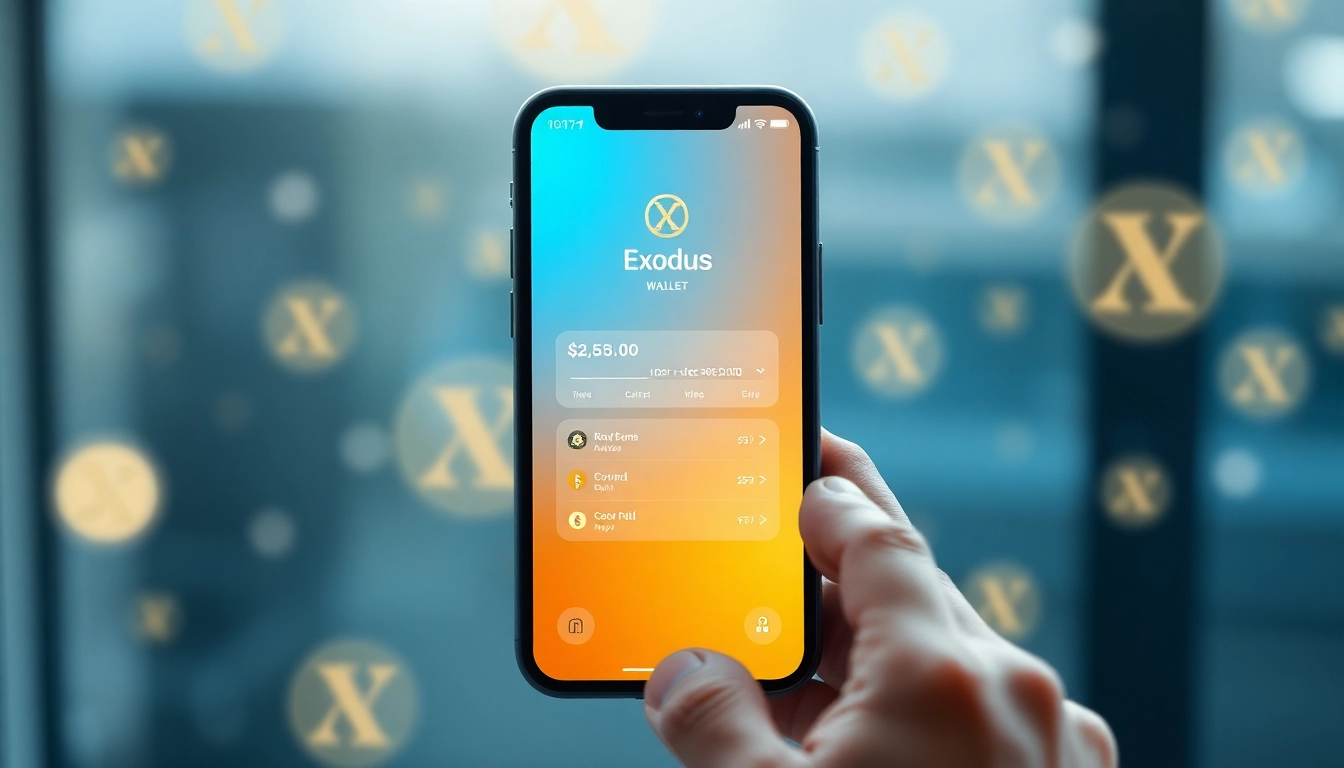Understanding the Exodus Wallet
What is Exodus Wallet?
The exodus wallet is a software cryptocurrency wallet that offers an intuitive and user-friendly interface for managing multiple cryptocurrencies. Initially launched in 2015, Exodus was designed with the aim of making the world of cryptocurrencies accessible to everyone, regardless of technical expertise. Since then, it has grown to support over 100 cryptocurrencies, allowing users to store, manage, and track their digital assets within a single application. The wallet is available on several platforms, including desktop, mobile, and web, making it a flexible solution for crypto enthusiasts on the go.
Features of the Exodus Wallet
- User-Friendly Interface: Exodus is known for its visually appealing and easy-to-navigate interface. This aspect makes it particularly appealing to newcomers.
- Multi-Currency Support: Users can manage a wide array of cryptocurrencies, with the ability to swap them within the wallet.
- Integrated Exchange: Exodus integrates with third-party exchanges, allowing seamless trading of cryptocurrencies without leaving the wallet.
- Portfolio Tracking: The wallet includes portfolio tracking features that allow users to monitor their crypto assets’ performance over time.
- Security Features: Exodus incorporates several security features, including encrypted private keys stored locally on the user’s device, ensuring that only the user has access to their funds.
- Customer Support: The Exodus team provides excellent customer support and a comprehensive knowledge base for users seeking assistance.
How Exodus Wallet Works
Exodus operates as a non-custodial wallet, meaning that users retain full control of their private keys. When a user sets up their Exodus wallet, a unique set of private keys is generated, which is stored locally on the user’s device. This decentralized nature of the wallet provides security, as users do not need to rely on a third party to manage their assets for them.
Transactions in Exodus are straightforward; users can send, receive, or exchange cryptocurrencies with just a few clicks. The wallet also offers an in-built exchange feature, enabling users to trade one cryptocurrency for another directly within the platform, thus streamlining the trading process.
Getting Started with Exodus Wallet
Setting Up Your Exodus Wallet
To set up an Exodus wallet, users must first download the software from the official website or their preferred app store. Once downloaded, the setup process is simple. Users need to follow these steps:
- Download and install the Exodus wallet application.
- Create a new wallet by following the on-screen instructions.
- Backup your recovery phrase in a secure location, as this will allow you to recover your wallet if you lose access to your device.
- Optionally, secure your wallet by enabling additional security measures, such as a pin code or biometric authentication.
Buying Cryptocurrencies with Exodus
Exodus has integrated several payment options that allow users to purchase cryptocurrencies directly from the wallet. Updated regularly, these services typically include credit card purchases or bank transfer options. Users can initiate the purchase process by selecting the ‘Buy’ option, following the prompts to complete their transaction with the chosen payment method. It’s important to note that fees may vary based on the payment provider and currency chosen.
Securing Your Exodus Wallet
Securing your Exodus wallet is of utmost importance. While the wallet provides a range of built-in security features, users must take proactive measures to enhance their wallet’s security further. Best practices include:
- Always back up the recovery phrase in a safe environment.
- Enable two-factor authentication wherever possible.
- Keep the software up to date to benefit from the latest security patches.
- Be wary of phishing attempts and only download the wallet from official sources.
Managing Your Crypto Assets
Exchanging Cryptocurrencies on Exodus Wallet
Exodus facilitates the exchange of cryptocurrencies without requiring users to create an account with an exchange platform. Users can easily swap one cryptocurrency for another within the wallet. The process is streamlined:
- Select the ‘Exchange’ feature within the wallet.
- Choose the cryptocurrencies you want to swap.
- Review and confirm the transaction details.
- Complete the swap, and the funds will reflect immediately.
Tracking Your Portfolio in Exodus
Exodus offers comprehensive portfolio tracking features, allowing users to monitor their investments’ performance over time. Users can access in-depth charts and statistics that display detailed information about their holdings. This feature aids in effective asset management and decision-making.
Utilizing Passive Income Features
Exodus also provides options for earning passive income through its integration with various staking platforms. By holding certain cryptocurrencies in the wallet, users can earn rewards over time. To utilize these features, users can:
- Identify and select cryptocurrencies that offer staking.
- Follow the guidelines within the wallet to stake their assets.
- Monitor their staking rewards through the wallet interface.
Exodus Wallet Security Concerns
Is the Exodus Wallet Safe to Use?
Determining the safety of any cryptocurrency wallet requires consideration of various factors. Exodus implements several security measures, including local storage of private keys and built-in encryption. However, as with any digital asset tool, there are risks involved:
- Hot Wallet Risks: As a hot wallet, Exodus is constantly connected to the internet, making it potentially vulnerable to hacking attempts. While the wallet does utilize robust security protocols, users should remain vigilant.
- Phishing and Scams: Users must be cautious of phishing scams that target wallet credentials.
- Backup and Recovery: A failure to correctly back up the recovery phrase could lead to total loss of access to assets.
Common Security Issues with Exodus Wallet
While there are numerous advantages to using Exodus, some common security issues have arisen:
- Account Hijacking: Users must be vigilant against phishing attempts and always ensure they are accessing the wallet through the official website or application.
- Device Security: Since the wallet operates on devices, the overall security of the device (such as antivirus software and device encryption) is crucial.
- Transfer Errors: Mistaken transfers can occur if users do not correctly review wallet addresses. Always double-check recipient addresses before transferring funds.
Tips to Enhance Your Exodus Wallet Security
Securing your Exodus wallet involves multiple steps:
- Stay informed about the latest security updates.
- Consider storing the bulk of your assets in cold wallets while using Exodus for smaller, day-to-day transactions.
- Regularly change passwords and enable biometric locks for added security.
- Educate yourself about common scam tactics in the cryptocurrency space.
Advanced Features of the Exodus Wallet
Integrating with Hardware Wallets
Exodus can integrate with hardware wallets such as Trezor, offering users a heightened level of security. By connecting these hardware devices, users can manage their assets directly through the Exodus interface while keeping their private keys offline. This setup combines the convenience of software wallets with the security of hardware solutions.
Exploring the Exodus Web3 Functionality
The Exodus wallet has begun to incorporate Web3 functionalities, allowing users to interact with decentralized applications (dApps) directly from the wallet. This development is significant for users who wish to engage with the growing world of decentralized finance (DeFi). By seamlessly connecting to dApps, users can trade, stake, and access other blockchain services without leaving the Exodus environment.
Analyzing User Feedback and Wallet Reviews
User reviews play an essential role in understanding the strengths and weaknesses of any software. In general, Exodus has been positively received, with users praising its simplicity and usability. However, areas for improvement have been highlighted, such as transaction fees that may be on the higher side compared to exchange platforms. Analyzing user feedback should be an ongoing process to adapt and improve the wallet’s features continuously.

